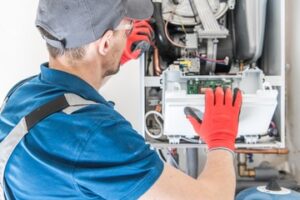Furnace repair is an essential aspect of maintaining a comfortable indoor environment, especially during the colder months when a properly functioning heating system is crucial. Homeowners and property managers often find themselves in need of furnace repairs due to various issues that can arise over time. Understanding the causes, symptoms, and solutions to common furnace problems can help prevent costly breakdowns and ensure that heating systems operate efficiently and safely. Contact Furnace Repair Houston for professional help.

One of the most common issues with furnaces is a lack of heat production. This problem can stem from various sources, including a malfunctioning thermostat, a clogged air filter, or issues with the ignition system. A malfunctioning thermostat may fail to properly communicate with the furnace, leading to incorrect temperature readings and preventing the system from turning on or shutting off at the desired settings. Clogged air filters restrict airflow, causing the furnace to overheat and shut down prematurely. The ignition system, whether it is a pilot light or an electronic igniter, plays a crucial role in initiating the heating process, and any failure in this component can prevent the furnace from generating heat.
Unusual noises coming from the furnace are another indication that repair may be necessary. Rattling, banging, or whistling sounds can be a sign of loose components, a failing blower motor, or air pressure imbalances within the system. These noises should never be ignored, as they can indicate underlying issues that, if left unaddressed, may lead to more significant damage. Regular maintenance and inspections can help identify and resolve these problems before they escalate.
Another common furnace problem is inconsistent heating throughout the home. This issue can be caused by blocked vents, ductwork leaks, or an improperly sized furnace. Blocked vents prevent warm air from circulating efficiently, leading to uneven heating. Leaks in the ductwork allow heat to escape before reaching its intended destination, reducing the system’s efficiency. If the furnace is too small for the space it is intended to heat, it may struggle to maintain a consistent temperature, leading to frequent cycling and increased energy consumption.
Short cycling, where the furnace turns on and off frequently, is another indication of a malfunction. This issue can be caused by an overheating system, a faulty thermostat, or airflow restrictions. Overheating often results from dirty filters or blocked vents, which cause the furnace to shut down as a safety precaution. A faulty thermostat may send incorrect signals to the furnace, leading to frequent cycling. Ensuring proper airflow and addressing thermostat issues can help resolve this problem and improve the furnace’s efficiency.
A noticeable increase in energy bills without a corresponding increase in usage is another sign that a furnace may require repair. A furnace that is working harder than necessary to produce heat is likely operating inefficiently due to worn-out components, clogged filters, or leaks in the ductwork. Regular maintenance, including cleaning or replacing filters and inspecting ductwork, can help improve efficiency and reduce energy costs.
Pilot light or ignition problems can also indicate the need for furnace repair. If the pilot light frequently goes out or the electronic ignition fails to start the furnace, it may be due to a faulty thermocouple, a clogged gas valve, or electrical issues. These components are essential for ensuring the safe operation of a furnace, and any malfunction should be addressed promptly by a qualified professional.
Another issue that homeowners may encounter is a furnace that produces a burning smell when turned on. While a slight burning odor when first activating the furnace for the season is normal due to dust accumulation, persistent smells can indicate problems such as overheating components or electrical issues. A musty smell could indicate mold growth within the ductwork, which can pose health risks and should be addressed immediately.
Regular maintenance is key to preventing furnace problems and extending the lifespan of the system. Homeowners should schedule routine inspections to check for worn-out components, clean the system, and ensure all parts are functioning correctly. Changing air filters regularly, inspecting ductwork for leaks, and ensuring vents remain unobstructed can go a long way in maintaining an efficient and reliable heating system.
For those experiencing furnace issues, attempting DIY repairs can sometimes be effective for minor problems such as replacing filters or resetting the thermostat. However, more complex repairs, such as fixing ignition systems, replacing motors, or repairing gas valves, should be left to professionals. Furnace systems involve electrical and gas components that require specialized knowledge and tools to repair safely.
Ignoring furnace problems can lead to more significant issues, including complete system failure, carbon monoxide leaks, and even fire hazards. If a furnace exhibits persistent issues such as failing to start, producing unusual noises, or emitting strange odors, it is essential to seek professional assistance promptly. A well-maintained furnace not only ensures a comfortable indoor environment but also contributes to energy efficiency and safety.
In many cases, the decision to repair or replace a furnace depends on the age and condition of the unit. If a furnace is over a decade old and requires frequent repairs, replacing it with a newer, more energy-efficient model may be a cost-effective long-term solution. Modern furnaces come equipped with advanced features that improve efficiency, reduce energy consumption, and enhance indoor air quality.
Ultimately, furnace repair is a crucial aspect of home maintenance that should not be overlooked. By recognizing early warning signs, performing regular maintenance, and seeking professional assistance when necessary, homeowners can ensure their heating systems remain in optimal condition. Whether addressing minor issues or considering a complete system replacement, taking proactive steps can help maintain a warm and comfortable home while minimizing energy costs and ensuring safety.